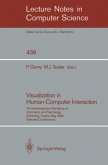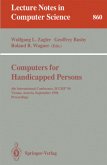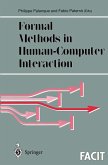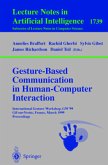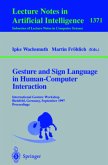BassThird International Conference, EWHCI '93, Moscow, Russia, August 3-7, 1993. Selected Papers
Human-Computer Interaction
Third International Conference, EWHCI '93, Moscow, Russia, August 3-7, 1993. Selected Papers
Mitarbeit:Bass, Leonard; Gornostaev, Juri; Unger, Claus
BassThird International Conference, EWHCI '93, Moscow, Russia, August 3-7, 1993. Selected Papers
Human-Computer Interaction
Third International Conference, EWHCI '93, Moscow, Russia, August 3-7, 1993. Selected Papers
Mitarbeit:Bass, Leonard; Gornostaev, Juri; Unger, Claus
- Broschiertes Buch
- Merkliste
- Auf die Merkliste
- Bewerten Bewerten
- Teilen
- Produkt teilen
- Produkterinnerung
- Produkterinnerung
The International Conference on Human-Computer InteractionEWHCI '93 was thethird conference in a series which startedin 1991 in Moscow. Like its predecessors, it was occasionedby the long separation of workers in HCI from one anotherand the new opportunity to learn from one another and tostart cooperations with each other. The conference wasinternational,with papers and participants from 16countries. This volume contains a selection of the bestpapers presented at the conference. The papers are groupedinto parts on: foundations of HCI; techniques, tools andparadigms for interface design;…mehr
Andere Kunden interessierten sich auch für
![Human Computer Interaction Human Computer Interaction]() GrechenigHuman Computer Interaction39,99 €
GrechenigHuman Computer Interaction39,99 €![Computer Human Interaction Computer Human Interaction]() Masood Masoodian / Steve Jones / Bill Rogers (eds.)Computer Human Interaction77,99 €
Masood Masoodian / Steve Jones / Bill Rogers (eds.)Computer Human Interaction77,99 €![Visualization in Human-Computer Interaction Visualization in Human-Computer Interaction]() GornyVisualization in Human-Computer Interaction39,99 €
GornyVisualization in Human-Computer Interaction39,99 €![Computers for Handicapped Persons Computers for Handicapped Persons]() Computers for Handicapped Persons39,99 €
Computers for Handicapped Persons39,99 €![Formal Methods in Human-Computer Interaction Formal Methods in Human-Computer Interaction]() Formal Methods in Human-Computer Interaction38,99 €
Formal Methods in Human-Computer Interaction38,99 €![Gesture-Based Communication in Human-Computer Interaction Gesture-Based Communication in Human-Computer Interaction]() Annelies Braffort / Rachid Gherbi / Sylvie Gibet / James Richardson / Daniel Teil (eds.)Gesture-Based Communication in Human-Computer Interaction39,99 €
Annelies Braffort / Rachid Gherbi / Sylvie Gibet / James Richardson / Daniel Teil (eds.)Gesture-Based Communication in Human-Computer Interaction39,99 €![Gesture and Sign Language in Human-Computer Interaction Gesture and Sign Language in Human-Computer Interaction]() WachsmuthGesture and Sign Language in Human-Computer Interaction39,99 €
WachsmuthGesture and Sign Language in Human-Computer Interaction39,99 €-
-
-
The International Conference on Human-Computer InteractionEWHCI '93 was thethird conference in a series which startedin 1991 in Moscow. Like its predecessors, it was occasionedby the long separation of workers in HCI from one anotherand the new opportunity to learn from one another and tostart cooperations with each other. The conference wasinternational,with papers and participants from 16countries. This volume contains a selection of the bestpapers presented at the conference. The papers are groupedinto parts on: foundations of HCI; techniques, tools andparadigms for interface design; information visualization;empiricalstudies; multimedia; hypertext; customizinginterfaces; teaching and learning; applications.
Produktdetails
- Produktdetails
- Verlag: Springer / Springer Berlin Heidelberg / Springer, Berlin
- Artikelnr. des Verlages: 978-3-540-57433-0
- 1993.
- Seitenzahl: 404
- Erscheinungstermin: 10. November 1993
- Englisch
- Abmessung: 235mm x 155mm x 22mm
- Gewicht: 536g
- ISBN-13: 9783540574330
- ISBN-10: 3540574336
- Artikelnr.: 09215688
- Herstellerkennzeichnung
- Springer-Verlag GmbH
- Tiergartenstr. 17
- 69121 Heidelberg
- ProductSafety@springernature.com
- Verlag: Springer / Springer Berlin Heidelberg / Springer, Berlin
- Artikelnr. des Verlages: 978-3-540-57433-0
- 1993.
- Seitenzahl: 404
- Erscheinungstermin: 10. November 1993
- Englisch
- Abmessung: 235mm x 155mm x 22mm
- Gewicht: 536g
- ISBN-13: 9783540574330
- ISBN-10: 3540574336
- Artikelnr.: 09215688
- Herstellerkennzeichnung
- Springer-Verlag GmbH
- Tiergartenstr. 17
- 69121 Heidelberg
- ProductSafety@springernature.com
Historical analysis and conflicting perspectives - Contextualizing HCI.- Structuring the field of HCI: An empirical study of experts' representations.- Coupling interaction specification with functionality description.- An extension to the human-computer interaction paradigm.- Hierarchical components of human-computer systems.- Synthesis-oriented situational analysis in user interface design.- WYSIWYG editors: And what now?.- Architecture elements for highly-interactive business-oriented applications.- Designing multimedia interfaces.- Iconic signs and languages in user interface development.- E3: Towards the metrication of graphical presentation techniques for large data sets.- Navigating in a process landscape.- Visualisation of complex information.- Three-dimensional visualisation of knowledge structures: Prototyping for design evaluation.- Visual programming in R-technology: Concepts, systems and perspectives.- Interface semantics and procedural knowledge: A study of novice understanding of MacDraw.- Positive test bias in software testing among professionals: A review.- Applying the Wizard of Oz technique to the study of multimodal systems.- The MSM framework: A design space for Multi-Sensori-Motor systems.- Radiological reporting based on voice recognition.- Task interference with a discrete word recognizer.- Model of utterance and its use in cooperative response generation.- Special computer interfaces for the visually handicapped: F.O.B. The manufacturer.- INTELTEXT: Producing coherent linear texts while navigating in large non-hierarchical hypertexts.- The challenge of effectively integrating graphics into hypertext.- Coherent navigation in hypertext environments: The SMIsC conception.- Generating self-adaptive human-computer interfaces.- The practical use ofmacro recording: A case study.- HyperLecture: A self-organizing lecture presentation and revision system.- Towards an adaptive hypermedia component for an intelligent learning environment.- An intelligent interface for computer assisted language learning.- A system to model, assist and control the human observation of microscopic specimen.- The "document-driven activity" approach to modelling and designing office automation systems.
Historical analysis and conflicting perspectives - Contextualizing HCI.- Structuring the field of HCI: An empirical study of experts' representations.- Coupling interaction specification with functionality description.- An extension to the human-computer interaction paradigm.- Hierarchical components of human-computer systems.- Synthesis-oriented situational analysis in user interface design.- WYSIWYG editors: And what now?.- Architecture elements for highly-interactive business-oriented applications.- Designing multimedia interfaces.- Iconic signs and languages in user interface development.- E3: Towards the metrication of graphical presentation techniques for large data sets.- Navigating in a process landscape.- Visualisation of complex information.- Three-dimensional visualisation of knowledge structures: Prototyping for design evaluation.- Visual programming in R-technology: Concepts, systems and perspectives.- Interface semantics and procedural knowledge: A study of novice understanding of MacDraw.- Positive test bias in software testing among professionals: A review.- Applying the Wizard of Oz technique to the study of multimodal systems.- The MSM framework: A design space for Multi-Sensori-Motor systems.- Radiological reporting based on voice recognition.- Task interference with a discrete word recognizer.- Model of utterance and its use in cooperative response generation.- Special computer interfaces for the visually handicapped: F.O.B. The manufacturer.- INTELTEXT: Producing coherent linear texts while navigating in large non-hierarchical hypertexts.- The challenge of effectively integrating graphics into hypertext.- Coherent navigation in hypertext environments: The SMIsC conception.- Generating self-adaptive human-computer interfaces.- The practical use ofmacro recording: A case study.- HyperLecture: A self-organizing lecture presentation and revision system.- Towards an adaptive hypermedia component for an intelligent learning environment.- An intelligent interface for computer assisted language learning.- A system to model, assist and control the human observation of microscopic specimen.- The "document-driven activity" approach to modelling and designing office automation systems.





